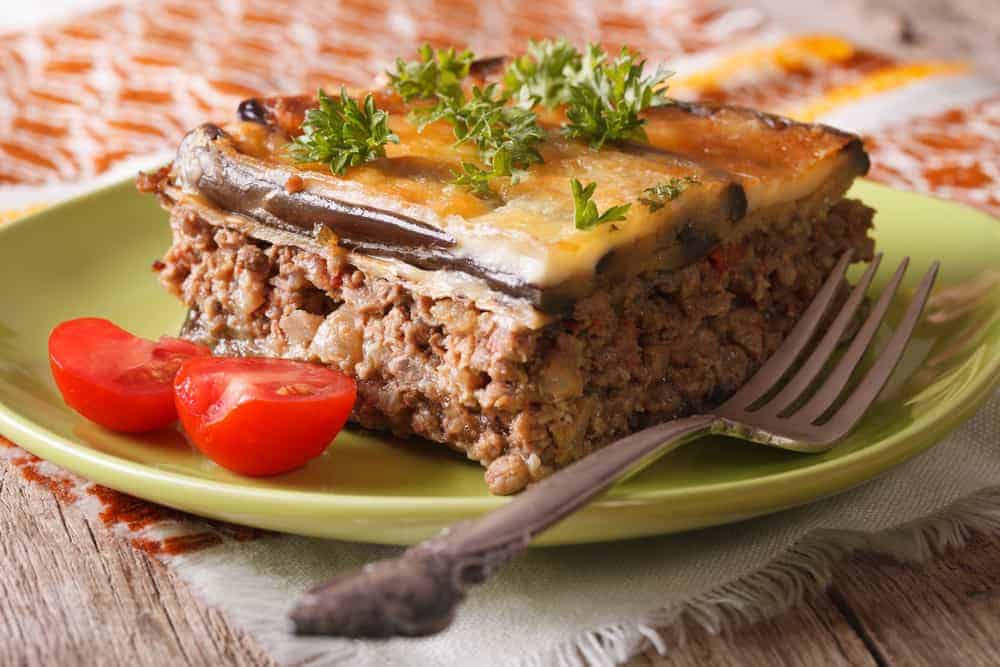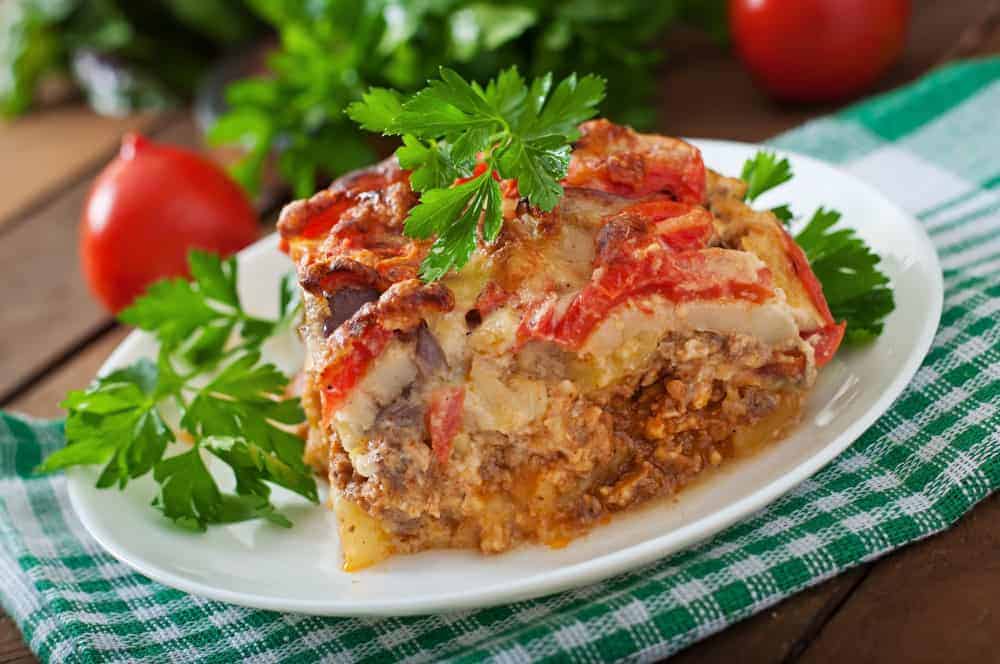Nosta Restaurant
Moussaka: A Delicious Greek Classic Meal
Published on:
September 29, 2021

Moussaka is not only popular in Greece, it is a popular dish for gourmets in the Middle East, the Balkans, Turkey, Egypt, the Levant and other regions. You can always find this famous dish in a
top restaurants near you.
This classic dish features a variety of flavours, a distinctive essence of ground meat, and a rich nutritional profile.
Moussaka is a healthier alternative to dishes made with heavily processed wheat and meat.
How did it get this fame, and how is it prepared? Here is everything you need to know about this popular Greek national dish.
How the Moussaka got its Name

Moussaka cuisine takes its name from the Arabic word musaqqa'ah. The word means cold or dipped in liquid. Greek and Turkish foodies adopted the name when the Arabs introduced it to the Mediterranean.
Turks and Greeks may have agreed on this Arabic name because moussaka is best served warm or cold. It is coated with a cheesy béchamel before baking.
The meat layer is also often prepared in tomato sauce.
The history of Moussaka

Although moussaka is famous as a Greek national dish, it was not invented in that country.
A mediaeval book titled 'A Baghdad Cookery book' suggests that moussaka originated in the Levant. It contains a musakhkhan recipe similar to that of moussaka. The cookbook was published around the 13th century.
But the ancient moussaka bore no resemblance to the popular layered version we know today. It was more like an eggplant stew. It was the Arab Immigrants, which introduced moussaka to Greece and Turkey in
outdoor dining areas.
In the 1920s, Nikolaus Tselementes, a well-known Greek chef and recipe writer, developed what is now the Greek version of moussaka.
He invented the layers and recommended the use of bechamel sauce.
How to prepare Greek Moussaka

There are several variations of moussaka. But the Greek version is the most original one, which you should definitely try.
Assuming you want to know how to prepare this dish before it lands on your plate, here are cooking instructions for you.
Moussaka preparation

Like any dish, preparing moussaka starts with getting the right ingredients. For a meal for four, you will need the following ingredients:
4 large potatoes, peeled and sliced 250 g ground beef or lamb 2 large eggplants, cut into thin rings 1 medium onion, chopped 2 cloves garlic, pressed or minced 25 ml red wine 1 tablespoon tomato paste 2 bay leaves 1 tablespoon olive oil 200 g chopped tomatoes.
For the bechamel sauce
25g butter
A pinch of black pepper
A pinch of cinnamon 25g flour 2 eggs, beaten
Grated cheese 250ml milk
Prepare the Moussaka
This classic dish consists of three layers, each prepared separately. Then the layers are assembled to make the delicious moussaka, which is celebrated in Turkey, Greece, the Balkans, Middle East and other countries.
Below are step-by-step instructions for preparing and assembling moussaka.
-Preparing the succulent layer of meat
Fry the ground meat and chopped onion in olive oil. Add salt, bay leaves, cinnamon, tomato puree, chopped tomatoes and pepper once the meat is browned. Let the meat and spices cook for a minute or two.
Deglaze it with red wine, lower the cooking temperatures and let the meat simmer until cooked. The meat should form a thick sauce for it to be considered done. Remember to stir the meat occasionally, so it does not stick to the bottom of the saucepan.
-Prepare the aubergines and potatoes
Season the eggplant rings with salt to reduce the bitterness of the vegetable. Fry the eggplant rings in a pan until they are golden brown. Remember to drizzle the pieces with a little olive oil before frying.
For the chopped potatoes, preheat the oven to 180 degrees Celsius. Coat a roasting tray with olive oil and place the potato slices in the tray. Bake the potatoes for 6 minutes.
-Prepare the béchamel sauce
Melt the butter in a pan over low heat. Add the flour to the melted butter and whisk quickly to form a thick paste. Then dilute the thick sauce with a bit of milk and whisk thoroughly to form a thick pudding.
Remove the pudding from the heat source. Season it with salt, cinnamon and pepper to enhance the taste. Add the egg yolks to the seasoned sauce and whisk thoroughly to make the bechamel sauce.
-Assembling the moussaka
Take a deep bowl and layer the potatoes underneath. Divide the eggplant rings in half. Layer the first part of the potatoes. Spread your meat sauce evenly on top of the eggplant sauce, then add the second portion of eggplant on top of your meat.
Spread the bechamel sauce evenly, making sure all of your moussaka is covered. Sprinkle some grated cheese over the bechamel layer. Bake the layers until the top is golden brown.
Your Greek moussaka is ready!
Other Moussaka Variants you should try out

Although the Greek Moussaka is considered the original version, there are several tasty variations from Turkey, the Levant and other parts of the world. They are just as delicious as the Greek Moussaka. Some of these moussaka variants that you should try are:
Moussaka Levante
The Levant Moussaka is also known as Maghmour and is a vegetable stew made with eggplant and chickpeas or meat. It does not contain potatoes, and the bechamel sauce is used in Greek Moussaka. The stew is served warm with rice, crusty bread or soft pita bread. Unlike the Greek moussaka, the Levantine version is easy to prepare. You can prepare it within 45 minutes.
Moussaka Egypt
Egyptian moussaka is a mixture of fried or grilled eggplant and green peppers. The eggplant and peppers are fried separately and then cooked in a sauce of sauteed garlic, chopped tomatoes and ketchup. It is best served warm with crisps or pita bread.
Moussaka Turkey
Turkish moussaka is similar to the Levant version. However, the Turkish version of moussaka is made with equal parts tomatoes, eggplant and ground meat. Cooks make this classic dish by separately shallow frying or baking thin rings of eggplant.
The minced meat, chopped tomatoes, onions, thyme and other spices are sautéed and mixed with the fried eggplants. Turkish moussaka is served warm with rice, pilaf, bread and seasonal vegetable salad.
Moussaka: A Simple and Delicious Dish
Moussaka has everything you want in a kitchen. It's creamy, delicious, nutritious and filling. While the Greek version with layers of baked eggplant, juicy meat and roasted potatoes is the most common, it's not the only variation.
Many regions have their own variants. The Levantine version looks like a stew of eggplant and chickpeas. It is served along with rice, soft pita bread or crusty bread. The Turkish version is similar to Levant Moussaka, but contains minced meat instead of chickpeas.
Despite the differences, both types of moussaka consist of eggplant and tomato as the main ingredients.
Frequently asked questions
What is the difference between lasagna and moussaka?
Moussaka has eggplant as the main ingredient. Some cooks add roasted or baked potatoes, ground meat, pepper and tomatoes to the recipe.
The traditional version consists of layers of potatoes, eggplant and ground meat. This cuisine is common in Greece, Turkey, the Middle East and the Levant.
In contrast, lasagna consists of layers of patties alternating vegetables, ground meat and cheese. Some foodies top this Italian comfort dish with mozzarella cheese. It is a special dish served at parties, potlucks, special dinners and dates.
What is traditionally served with moussaka?
Traditionally, Greek moussaka was served alongside a fresh mint salad, chopped tomatoes, parsley and cucumbers. However, moussaka is not limited to these vegetables. You can serve it anytime with your favourite salad.
Why is it called moussaka?
The name was taken from the Arabic word Mussaqqa'a, which means cold or soaked in liquid. Turkish and Greek cooks probably settled on this name simply because the delicacy moussaka is best served cold or warm.
Does moussaka contain gluten?
Yes, moussaka does contain gluten. The bechamel sauce used as a topping for moussaka is made from wheat flour, a rich source of gluten. However, if gluten is a concern, use the gluten-free version made from corn, potato and arrowroot starch.
How many calories does homemade moussaka contain?
Moussaka has about 140 calories in 100 grams. The calories come from potatoes, eggplant, olive oil and meat. However, the calorie count always depends on the amount of meat, oil, potatoes and eggplant you use in your moussaka.
Does moussaka come from Greece?
Although it is hailed as a Greek national dish, moussaka was not invented in that country. Historical records show that it was invented in the Levant. Later, Arab immigrants brought the dish to Greece via Turkey.
Should eggplants be salted before cooking?
It is not a must to salt your eggplant pieces before cooking. However, some chefs recommend rinsing your eggplants with more water and salting them before cooking to improve the flavour of the eggplant. The salt takes away the bitter taste of the vegetable. Also, some people report that salted eggplant absorbs less vegetable oil.





